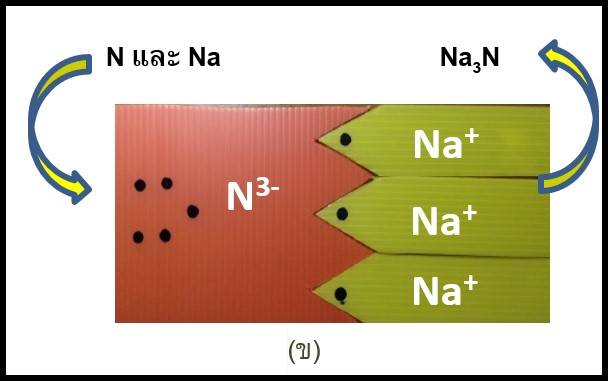การสำรวจมโนมติทางวิทยาศาสตร์ เรื่อง สารโคเวเลนต์และไอออนิกโดยใช้เทคนิคแบ่งกลุ่มผลสัมฤทธิ์ร่วมกับบัตรแสดงพันธะเคมี
Main Article Content
Abstract
Atchareerat Siri, Pranorm Saejueng and Karntarat Wuttisela
รับบทความ: 21 พฤษภาคม 2558; ยอมรับตีพิมพ์: 25 พฤศจิกายน 2558
บทคัดย่อ
งานวิจัยนี้มีวัตถุประสงค์เพื่อสำรวจมโนมติทางวิทยาศาสตร์ มโนมติที่คลาดเคลื่อน และมโนมติที่ผิดของนักเรียนที่เรียนด้วยเทคนิคแบ่งกลุ่มผลสัมฤทธิ์ร่วมกับบัตรแสดงพันธะเคมี เรื่อง การเขียนสูตรและการเรียกชื่อของสารโคเวเลนต์และไอออนิก แบบแผนวิจัยเป็นแบบกลุ่มเดียวสอบก่อนเรียนและหลังเรียน กลุ่มที่ศึกษาในการวิจัยนี้ ได้แก่ นักเรียนชั้นมัธยมศึกษาปีที่ 4 จำนวน 32 คน ภาคเรียนที่ 1 ปีการศึกษา 2557 เครื่องมือที่ใช้ในการวิจัย ได้แก่ แบบวัดผลสัมฤทธิ์แบบปรนัยชนิดตัวเลือก 2 ลำดับขั้น และแผนการจัดการเรียนรู้เทคนิคแบ่งกลุ่มผลสัมฤทธิ์ร่วมกับบัตรแสดงพันธะเคมี บัตรนี้สร้างขึ้นจากพอลิโพรพิลีนบอร์ดประกอบด้วยบัตรแสดงพันธะไอออนิกและพันธะโคเวเลนต์ การวิเคราะห์ข้อมูลใช้ค่าเฉลี่ย ร้อยละ การทดสอบที และความก้าวหน้าทางการเรียน ผลการศึกษา พบว่า มโนมติที่ถูกต้องของนักเรียนที่เรียนด้วยกิจกรรมการเรียนรู้โดยเทคนิคแบ่งกลุ่มผลสัมฤทธิ์ร่วมกับสื่อการเรียนรู้บัตรแสดงพันธะเคมีเพิ่มขึ้นหลังเรียนสูงกว่าก่อนเรียนที่ระดับนัยสำคัญ .05 ในขณะที่มโนมติที่คลาดเคลื่อนและมโนมติที่ผิดลดลง โดยการเขียนสูตรและการเรียกชื่อ นักเรียนมีความก้าวหน้าในเรื่องสารไอออนิกมากกว่าสารโคเวเลนต์ สำหรับมโนมติคลาดเคลื่อนมากที่สุดคือเรื่องการอ่านชื่อสารโคเวเลนต์โดยนักเรียนอ่านเลขจำนวนอะตอมเป็นภาษากรีกไม่ถูกต้อง คิดเป็นร้อยละ 40.63 และนักเรียนที่ไม่สามารถเขียนสูตรไอออนิกเพราะไม่รู้สัญลักษณ์ของธาตุคิดเป็นร้อยละ 37.50
คำสำคัญ: เทคนิคแบ่งกลุ่มผลสัมฤทธิ์ มโนมติ สารไอออนิก สารโคเวเลนต์ บัตรแสดงพันธะเคมี
Abstract
The purposes of this study were to survey good conceptions, alternative conceptions, and misconceptions of students who experienced with student team achievement division-based learning incorporated with chemical bonding cards (STAD & card) on nomenclature and writing formulas of ionic as well as covalent compounds. The one-group pretest-posttest design was employed. Research samples were 32 students of 10th grade studying in the first semester, academic year 2014. Research instruments were 2-tier multiple choice conceptual tests and STAD & card-based lesson plans. The cards created from a polypropylene board consisted of ionic and covalent cards. Data were analysed by means, percentage, t-test, and learning gain. Findings showed the good conceptions of students who had learnt through STAD & cards techniques were increased higher than the pretest at the significant level of .05, whereas the alternative conceptions and misconceptions were decreased. According to formula writing as well as nomenclature, students’ learning gains on ionic compounds were greater than those of covalent compounds. The highest misconception, the nomenclature of covalent compounds by writing the incorrect Greek prefixes of compound names to denote the number of atoms, was 40.63%. In addition, students who cannot write the ionic formulas as they did not recognized the element symbols were in 37.50%.
Keywords: Student team achievement division (STAD), Conceptions, Ionic compounds, Covalent compounds, Chemical bonding cards
Downloads
Article Details

This work is licensed under a Creative Commons Attribution-NonCommercial 4.0 International License.
References
Chanfoo, O. (2011). The Study of Grade-10 Students’ Conceptions about Chemical Bonding through Constructivist Approach. M.Ed. in Science Education. Bangkok: Department of Education, Kasetsart University. (in Thai)
Chantapan, K., Wuttisela, K., and Jitcharoen, J. (2011). Effects of cooperative learning and interactive multimedia upon learning achievement on periodic table of 10-grade students. The Northern Region Journal of Science and Technology 3(Extra): 202–209. (in Thai)
Coll, R. K., and Taylor, N. (2001). Alternative conceptions of chemical bonding held by upper secondary and tertiary students. Research in Science & Technological Education 19(2): 171–191.
de Posada, J. M. (1997). Conceptions of high school students concerning the internal structure of metals and their electric conduction: structure and evolution. Science Education 81: 445–467.
Inboonna, S. (1998). Misconceptions in Acid-Base of Upper Secondary School Level Students in Nakhon Si Thammarat Province. M.Ed. in Science Education. Pattani: Prince of Songkla University. (in Thai)
Kiatsomkit, N. (2008). A comparison of Chemistry Learning Achievement Entitled “Chemistry Bonds” and Integrated Science Process Skills of Mathayomsuksa 4 Students Taught Using the STAD Cooperative Learning Method and the Conventional Method. M.Ed. in Science Education, Thepsatri Rajabhat University. (in Thai)
Maplai, P. (2010). A Study of Learning through Instruction Packages on Molecular Covalent Shape for Mathayomsuksa four by Cooperative Learning Individualized. M.Ed. in Educational Technology. Nakorn Prathom: Silpakorn University. (in Thai)
Muangkeaw, P., Wuttisela, K., and Pungpo, P. (2010). Enhancing learning with cooperative learning in electrochemistry. Journal of Research Unit on Science, Technology and Environment for Learning 1(1): 20–27. (in Thai)
Panich, V. (2012). Learning Method for Students in 21st Century. Bangkok: Tathata. (in Thai)
Parasak, P., and Wuttisela, K. (2013). Normalize gain of student’ learning achievement through cooperative learning in the topic of stoichiometry. The National Graduate Research Conference 2013 (pp. 403–410). Buriram: Buriram Rajabhat University. (in Thai)
Ruddick, K. R., and Abby, L. (2012). An interlocking building block activity in writing formulas of ionic compound. Journal of science education 89: 1436–1438.
Selco, J. (2013). Discovering periodicity: hands-on, minds-on organization of periodic table by visualizing the unseen. Journal of Chemical Education 90: 995–1002.
Strike, K. A., and Posner, G. J. (1992). A revisionist theory of conceptual change. In R. A. Duschl and R. J. Hamilton (Eds.), Philosophy of science, cognitive psychology, and educational theory and practice (pp.147–176), Albany, NY: State University of New York.
Taber, K. S. (2003). Mediating mental models of metals: acknowledging the priority of the learner’s prior learning. Science Education 87(5): 732–758.
Urasin, S., and Supasorn, S. (2011). Comparing students’ conceptions of chemical bonds prior and after the implementation of paper-based T5 learning model. KKU Research Journal 1(1): 38–57. (in Thai)
Witzel, J. E. (2002). Lego stoichiometry. Journal of Chemical Education 79(3): 352A–352B.
Wuttisela, K. (2014). An alternative molecular model for teaching valence shell electron pair repulsion theory. Journal of Re-search Unit on Science, Technology and Environment for Learning 5(2): 209–213. (in Thai)
